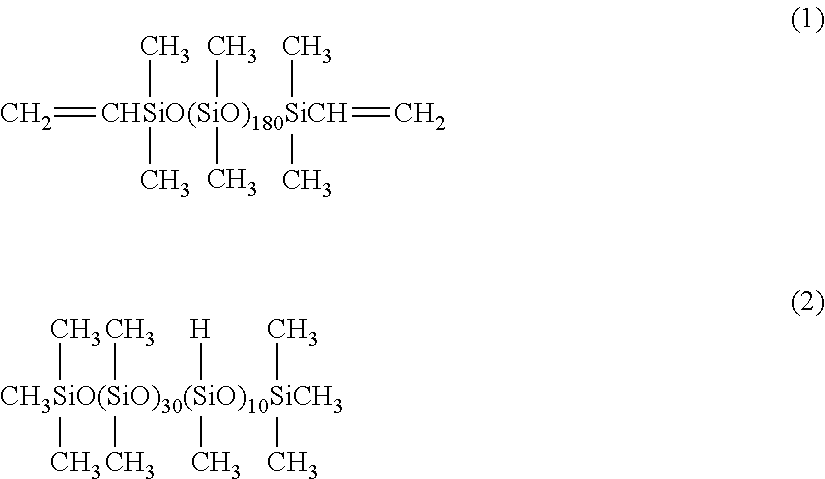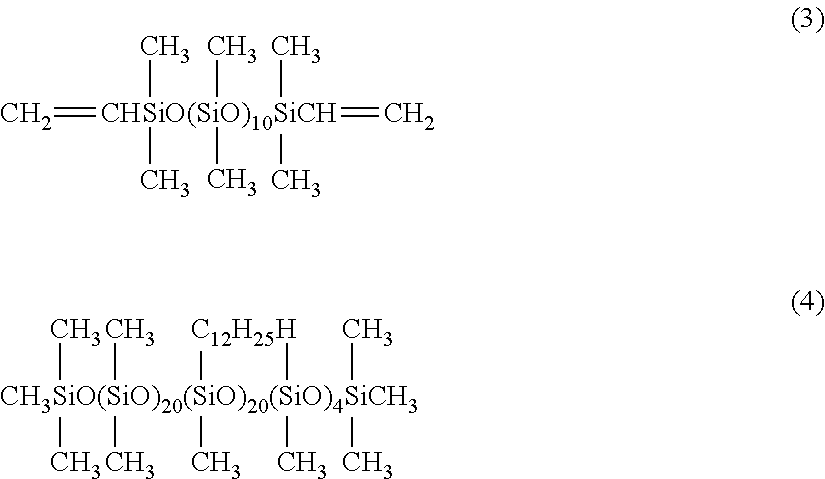Silicone microparticle and method for producing the same
a technology of silicon microparticles and microparticles, which is applied in the field of silicon microparticles and methods for producing the same, can solve the problems of difficult classification and decrease of resin strength, and achieve the effects of low agglomeration tendency, excellent dispersibility, and reduced agglomeration tendency
- Summary
- Abstract
- Description
- Claims
- Application Information
AI Technical Summary
Benefits of technology
Problems solved by technology
Method used
Image
Examples
example 1
[0077]Into a 1-L glass beaker were taken 500 g of a methyl vinyl polysiloxane having a dynamic viscosity of 600 mm2 / second as shown by the following formula (1) and 20 g of a methyl hydrogen polysiloxane having a dynamic viscosity of 30 mm2 / second as shown by the following formula (2) (blending ratio of the hydrosilyl group to the olefinic unsaturated group is 0.90 to 1), and they were dissolved by agitation with a homomixer at 2000 rpm. Thereafter, 5 g of polyoxyethylene octyl phenyl ether (addition number of moles of ethylene oxide is 9 mole) and 150 g of water were added thereinto; and then, the resulting mixture was agitated by using a homomixer at 6000 rpm, whereby giving an oil-in-water state having increased viscosity; the agitation was continued for further 15 minutes. Then, 329 g of water was added thereinto with agitation at 2000 rpm to obtain a white, homogenous emulsion. This emulsion was transferred to a 1-L glass flask equipped with an agitator having an anchor blade; ...
example 2
[0084]A silicone microparticle was obtained in a manner similar to that in Example 1 except that 1.3 g (this amount corresponds to 0.05 part by mass relative to 100 parts by mass of water) of a cationic cellulose (trade name of Poise C-60H; manufactured by Kao Corp.) was used instead of 3.3 g of the 40% aqueous solution of dimethyl diallyl ammonium chloride polymer (trade name of ME Polymer H40W; manufactured by Toho Chemical Industry Co., Ltd.) in Example 1.
[0085]The silicone microparticles thus obtained were dispersed into water by using a surfactant; and particle size distribution similar to that of the aqueous disperse solution of the foregoing silicone elastomer microparticles, having volume-average particle diameter of 3 μm, was obtained by a particle size distribution measurement instrument using an electric resistance method (Multisizer 3; manufactured by Beckman Coulter, Inc.).
[0086]It was confirmed by observation with an electron microscope that this silicone microparticle...
example 3
[0087]A silicone microparticle was obtained in a manner similar to that in Example 1 except that 4.4 g (this amount corresponds to 0.05 part by mass of dodecyl trimethyl ammonium chloride relative to 100 parts by mass of water) of 30% dodecyl trimethyl ammonium chloride (trade name of Cation BB; manufactured by NOF Corp.) was used instead of 3.3 g of the 40% aqueous solution of dimethyl diallyl ammonium chloride polymer (trade name of ME Polymer H40W; manufactured by Toho Chemical Industry Co., Ltd.) in Example 1.
[0088]The silicone microparticles thus obtained were dispersed into water by using a surfactant; and particle size distribution similar to that of the aqueous disperse solution of the foregoing silicone elastomer microparticles, having volume-average particle diameter of 3 μm, was obtained by a particle size distribution measurement instrument using an electric resistance method (Multisizer 3; manufactured by Beckman Coulter, Inc.).
[0089]It was confirmed by observation with...
PUM
| Property | Measurement | Unit |
|---|---|---|
| size | aaaaa | aaaaa |
| volume-average particle diameter | aaaaa | aaaaa |
| volume-average particle diameter | aaaaa | aaaaa |
Abstract
Description
Claims
Application Information
 Login to View More
Login to View More - R&D
- Intellectual Property
- Life Sciences
- Materials
- Tech Scout
- Unparalleled Data Quality
- Higher Quality Content
- 60% Fewer Hallucinations
Browse by: Latest US Patents, China's latest patents, Technical Efficacy Thesaurus, Application Domain, Technology Topic, Popular Technical Reports.
© 2025 PatSnap. All rights reserved.Legal|Privacy policy|Modern Slavery Act Transparency Statement|Sitemap|About US| Contact US: help@patsnap.com



